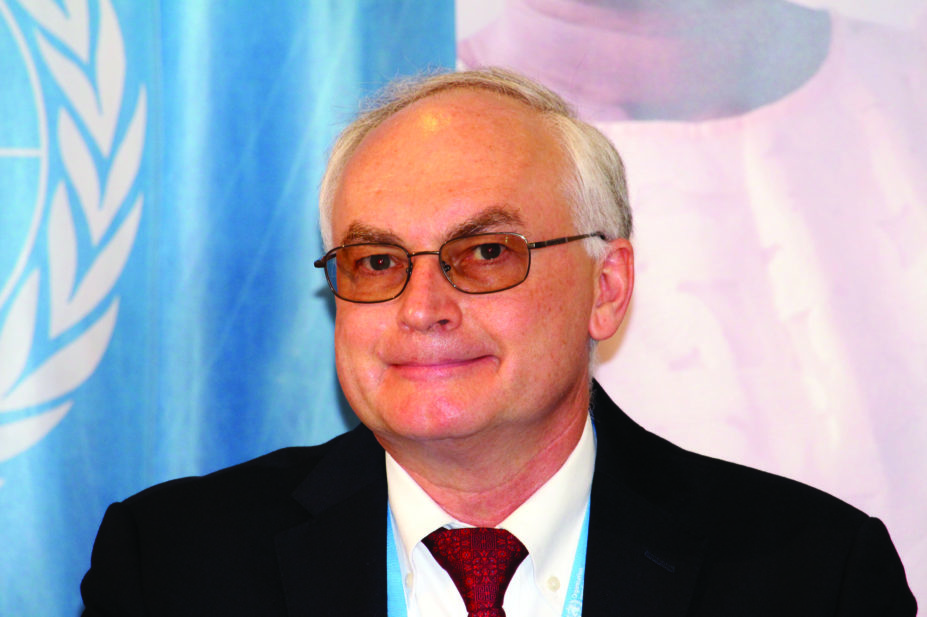
John Zarocostas
Marc Bulterys is team leader of the global hepatitis programme (GHP) at the World Health Organization (WHO). With his team, he provides scientific expertise and co-ordinates global technical activities related to viral hepatitis prevention and control. Previously, he worked for 19 years at the US Center for Disease Control and Prevention.
New WHO data from 28 countries show that efforts in fighting viral hepatitis are gaining momentum. What are some of the key findings?
A number of countries are starting to take action against viral hepatitis. Some of our champion countries include Mongolia, Egypt, Georgia and Vietnam. They are providing screening and treatment for hepatitis B and C. Often it is being incorporated into national health insurance systems, so almost everyone in the country would have access to the treatment.
At WHO we have been monitoring the global response to the hepatitis B and C epidemics. We focused on 28 countries, which account for about 70% of the global burden, and we can see that a number of these countries are now making interventions. However, challenges still remain. For example, we have good coverage of immunisation during childhood for hepatitis B, starting at six weeks of age, but do not have good coverage of hepatitis B immunisation for birth dose vaccine, particularly in the African region. The Western Pacific, including China, and the Americas, has high coverage.
The WHO wants to eliminate hepatitis as a global health threat and reduce infections by 90% and mortality by 65% by 2030, compared with the baseline of 2015. Is this possible given that, in 2015, an estimated 1.34 million people died from hepatitis?
These are ambitious targets but they are achievable, and some of the champion countries are showing the way. Among high-income countries we have examples from Australia, France, Portugal and Germany showing that it is possible to eliminate hepatitis C in a much shorter period than the 13 years required by 2030. Some countries are offering large-scale screening programmes to those at highest risk, and then providing treatment for all. In low- and middle-income countries we have Egypt, Georgia, Mongolia and Brazil, and now also some sub-Saharan African countries such as Rwanda, Cameroon and Zimbabwe, starting to develop programmes with large-scale screening and provision of treatment.
Direct-acting antivirals are effective drugs that can cure approximately 95–98% of hepatitis C patients
For hepatitis C we have a cure available. The direct-acting antivirals (DAAs) are effective drugs that cure approximately 95–98% of patients with a treatment regimen of 2–3 months (usually 3 months). For hepatitis B, not everyone requires treatment, but we have several drugs available, particularly tenofovir, which is also used in HIV infection as part of an antiretroviral (ARV) drug regimen. Tenofovir is also highly effective against hepatitis B and so, for a lot of people who have a high viral load or more advanced disease, it is recommended that they are placed on tenofovir or entecavir. Those two drugs are available in most countries.
The WHO recently put on the model list of essential medicines the regimens for all six genotypes of hepatitis C. Are there any plans to add more hepatitis drugs to the list?
The model list of essential medicines is updated by WHO every two years. We updated it in April 2017 and included a combination treatment of two of the pan-genotypic regimens that are now available: sofosbuvir with velpastasvir. There are other pan-genotypic regimens that are currently undergoing US Food and Drug Administration and European Medicines Agency approval. They are in the review process and, as they become available, there will be even more potential regimens available the next time the model list is updated in 2019.
Hepatitis C…is a fast-moving field and new regimens become available every few months
We are also working with our guidelines development group to update the guidelines again for hepatitis C. We last updated them in 2016. This is a fast-moving field and new regimens are becoming available every few months. We are doing our best to keep all the information updated in our guidelines. This is particularly important for the pan-genotypic regimens. We want to make sure it will be easier and more simplified if we do not need to do the genotyping test any more.
On 21 July 2017 the WHO prequalified — assessed the quality, safety and efficacy of medicinal products — the first generic version of sofosbuvir (manufactured by Mylan, India). Are there other hepatitis drugs in the pipeline, and how far are they from being prequalified?
There are two other products that will likely be prequalified soon, which we cannot disclose for now (a total of four products are in the WHO prequalification pipeline). We are expecting that to happen in the next one or two months. It depends on the responses that are also coming back from the companies.
Are these drugs branded or generics?
These are generics. There are brand drugs as well that have been prequalified by WHO, such as daclatasvir (BMS) for instance. But usually what WHO does is focus on the generic drugs. More than 100 countries now have access to the generic drugs because of voluntary licensing agreements, and the generics are now being produced in a variety of countries. For instance, Egypt, Pakistan, India and Morocco are producing their own DAAs. India has at least five companies that are producing DAAs. There will be substantial competition also between the generic companies, which should further help drive down some of the prices.
With voluntary arrangements, WHO research shows that the price for 2–3 months of hepatitis C drug treatment can be between US$200–US$280 per month. However, in rich countries prices are still high and range between US$30,000–US$45,000 for 3 months’ treatment. Are there any initiatives under way to lower prices in rich countries as well, given the pressure on health budgets?
If there is further competition in the market, the price of these drugs in high-income countries might also start to come down, and some countries have been good at negotiating for a whole package of hepatitis elimination. Australia is a good example. It has negotiated essentially for a price of providing treatment for everyone in the country. To be able to do that, they made available a certain sum of money and Australia is now quickly providing treatment to people living with hepatitis C. It has scaled up rapidly, and the price it is paying per patient is much lower than in many other countries.
Some countries, such as Malaysia and Thailand, do not have access to the generic drugs yet
However, the negotiation was not done on an individual basis, but as an entire package for the country. Some other countries are now following in Australia’s footsteps, such as France and the Netherlands. But there are some countries, such as Malaysia and Thailand, which do not have access to the generic drugs yet. They also have not negotiated low prices with the originator companies and so will be paying high prices for the drugs.
Despite the advances highlighted, only 1.1 million out of 14 million people diagnosed with hepatitis C (from the 71 million with the disease), and only 1.8 million of the 22 million diagnosed with hepatitis B (of 257 million infected), had access to treatment. What are the prospects of seeing a large increase in access to treatment?
There is still a massive gap in the testing and this needs to be addressed. In particular, countries that are highly burdened have to make testing far more available to the population. Viral hepatitis, until recently, was a neglected epidemic. This epidemic causes as many deaths as tuberculosis or HIV. But thanks to the advent of the DAAs, which became available at the end of 2013, you see a stronger interest in fighting hepatitis.
A functional cure for hepatitis B is possible in the next 5–10 years
There is a lot of research going on to find a cure for hepatitis B. However, it is likely to be what is called a functional cure because the virus integrates itself into the DNA of the cells, similar to HIV. An actual cure is more difficult to obtain. But a functional cure, many of the scientists believe, is possible in the next 5–10 years.
How many of the transmissions of viral hepatitis are due to unsafe practices in health facilities?
Unsafe health practices play an important role in the transmission of viral hepatitis. This is particularly true for hepatitis C. If we look at countries such as Egypt or Pakistan, a good portion of the transmissions that occur are due to unsafe practices in their health systems. Blood transfusion could be part of it, but it is more often because of unsafe injections.
Any final thoughts on how we can advance the mission of eliminating hepatitis?
We encourage policymakers in all countries, as well as the communities with them, to make testing and treating hepatitis a priority. We do not see any reason why so many people should still be dying from viral hepatitis B and C because we have an effective treatment regimen now. There is a great opportunity to eliminate hepatitis in the next 10–15 years.

